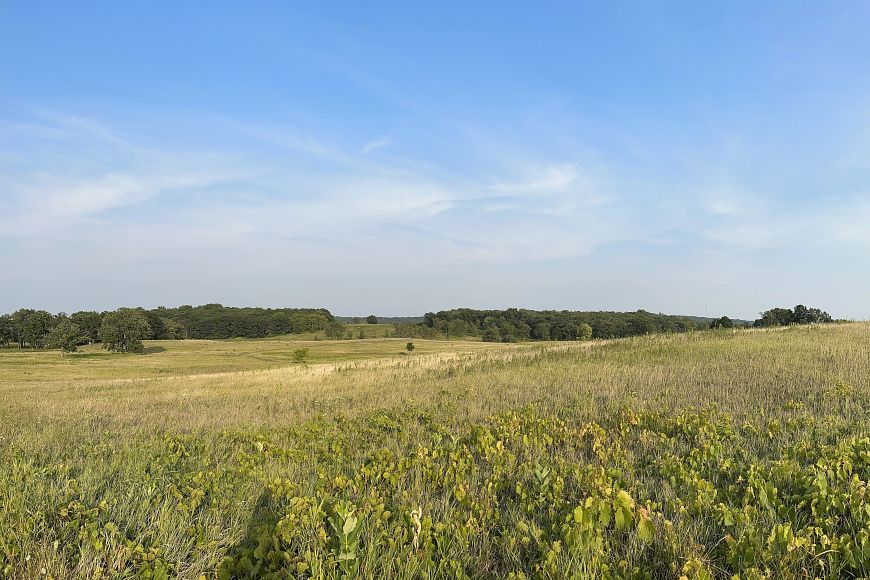Contact: Craig Czarnecki, DNR Air Management Program Outreach Coordinator Craig.Czarnecki@wisconsin.gov or 608-250-0945
DNR Celebrates Air Quality Success During Clean Air Month
 This May, the Wisconsin DNR celebrates Clean Air Month and reminds Wisconsinites that our air is something we all share.
Photo credit: Wisconsin DNR
This May, the Wisconsin DNR celebrates Clean Air Month and reminds Wisconsinites that our air is something we all share.
Photo credit: Wisconsin DNR
MADISON, Wis. – The Wisconsin Department of Natural Resources (DNR) celebrates Clean Air Month this May, an important time to remember our collective responsibility to protect the air we all breathe.
Air quality successes over the last 20 years include an 88% decrease in sulfur dioxide concentrations, a 26% decrease in fine particle pollution and a 21% decrease in statewide ozone concentrations. More information is available in the DNR’s 2023 Wisconsin Air Quality Trends Report.
“The environmental progress of the last two decades, including improvements in overall air quality in Wisconsin, is a major success story,” said DNR Deputy Secretary Steven Little. “The DNR is committed to continuing its mission and fostering climate-positive initiatives, including staying proactive to ensure cleaner air.”
Ongoing DNR efforts to promote and protect Wisconsin’s air quality include:
- Clean Diesel & Clean School Bus Funding – The DNR administers funding opportunities through the Wisconsin Clean Diesel Grant and Clean School Bus Programs. Diesel engines emit harmful pollutants that can contribute to serious public health problems, especially in school-aged children whose lungs are still developing. Since 2008, these programs have updated or replaced more than 5,200 pieces of equipment, reducing diesel emissions by more than 625,000 tons.
- American Rescue Plan Monitoring project – In partnership with the Environmental Protection Agency and several Milwaukee community organizations, the DNR is setting up a study to provide publicly available, real-time air sensor data near one of the DNR’s Milwaukee air monitoring sites. This project is designed to identify areas where air quality disparities exist and inform mitigation options that can be implemented locally to resolve disproportionate impacts.
- New Air Permitting resources – The DNR posted new resources to the Air Permit Public Involvement webpage. In addition to searching for active permits, the public can use the Public’s Guide to the Air Permit Process and the Air Permit Decisions - Right to Appeal documents to better understand the air permitting process and find ways to get involved.
- Wildfire smoke impacts – Canadian wildfires in 2023 burned 45 million acres of land and caused unprecedented smoke events. Wisconsin’s most significant wildfire smoke impacts occurred from June 26-30, 2023, during which the DNR’s air monitoring network measured some of the highest particulate matter (PM5) concentrations ever recorded in the state. In response, the DNR created a Wildfire Smoke webpage with tips and resources to prepare for future severe wildfire episodes.
“Though air quality progress has been made in much of the state and is something important to celebrate, there are more challenges ahead,” said Gail Good, DNR Air Management Program Director. “We will continue to address Wisconsin-specific air quality challenges and make progress on air quality in our communities.”
Children around the state are participating in the air quality celebration with the DNR’s 13th annual Air, Air Everywhere Poetry Contest. Winners will be announced at the end of the month, and winning poems will be posted on the contest webpage.
For more ways to stay up to date on the current air quality:
- Visit DNR’s Do a Little, Save a Lot webpages for ideas on reducing our impact on the climate and environment.
- View the DNR’s 2023 Wisconsin Air Quality Trends Report and the interactive StoryMap, which show Wisconsin's air quality trends for each pollutant over the last 20 years.
- Download the free WisconsinAQM mobile app to receive air quality updates on your mobile device. The app includes an interactive view of near real-time data from the state’s air monitoring network, individual monitoring stations, weather information and more.
- Subscribe to the DNR's air quality news and notices newsletter.
Visit the Clean Air Month webpage for more links to resources and information.

